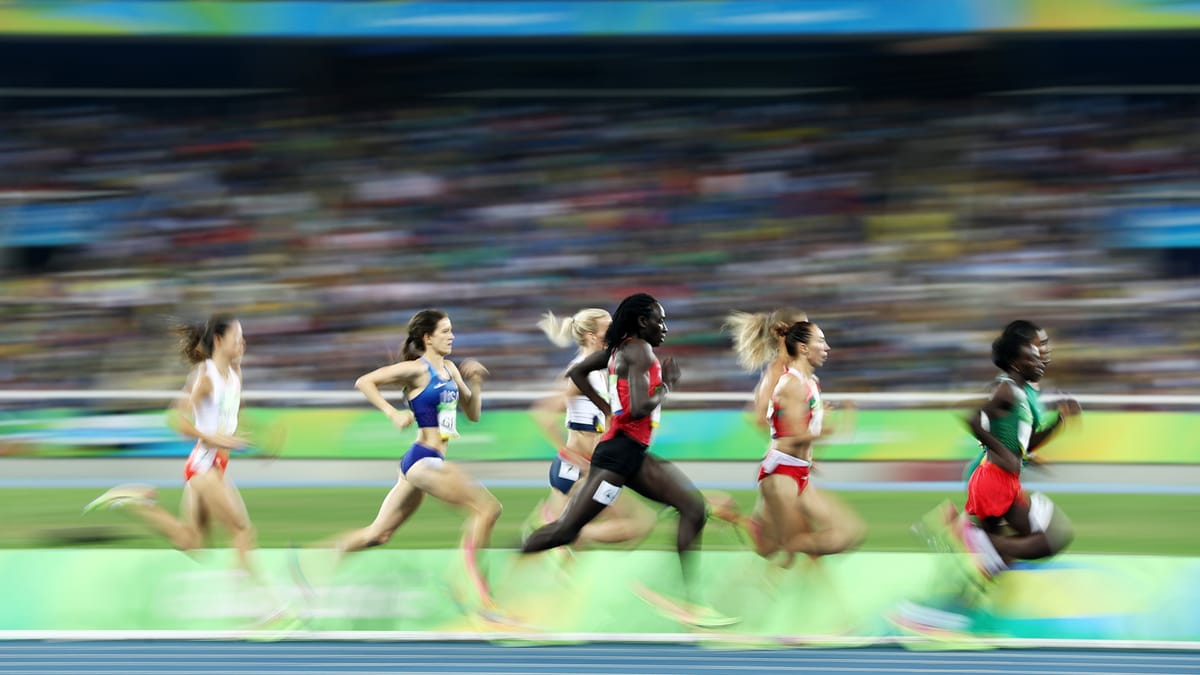Rewriting the rulebook
Indignity Vol. 5, No. 180

LAW DEP'T.
Anti-Trans Professors Pretend to Understand Sports
S.I. ROSENBAUM WROTE a piece for Flaming Hydra yesterday about an amicus brief that 24 professional scholars submitted to the Supreme Court, in which they expressed their support, as philosophers, for efforts by Idaho and West Virginia to ban trans girls and trans women from playing girls and women's sports. Rosenbaum eloquently explained the bigotry the amici were presenting in the brief, and their misunderstanding and misrepresentation of philosophical history.
When I read the brief for myself, though, what struck me was how ignorant the professional thinkers were about sports. They were also shockingly bad at thinking in general, in a genuinely upsetting way. If the brief weren't written to tell the Supreme Court majority what it presumably already wants to hear—that trans girls aren't girls, and that the rules of nature and of fair play alike insist on this obvious truth—it might even be insulting to the justices.
Speaking as experts, the professors told the court that philosophically, one may distinguish between "natural" categories of things and "gerrymandered" categories of things, and that the difference between those two categories of categories of things "is a widely applicable and projectible distinction." To illustrate the premise, they offered a sample of paired categories: "Water" versus "Water located in Lake Erie"; "Car" versus "Car owned by Bill Clinton"; "Mammal" versus "Mammal discovered before 1830."
The goal of this setup was to work around to eventually drawing a distinction between the categories of "Female (person)" and "Female or person who identifies as female"—that is, though they avoided anything anywhere near such terminology, between sex classification and gender identity. Sex classification would be the "natural" category, and gender identity would be the "gerrymandered" one. "[L]awmakers," they wrote, "are justified in drawing the line exactly at the boundary between males and females, given that it is the most natural line in the vicinity."
But the amici fell victim to their own metaphor. The distinctions in each of their example pairs were obvious because the categories were, in fact, gerrymandered—that is, the professors had constructed them entirely artificially, to serve an ulterior motive, in a way that was obviously hostile to the principle of representation. "Water located in Lake Erie" was not a category anyone uses in the real world; it was a parody of a category, designed to be useless and absurd, so that gender identity could by extension also be treated as useless and absurd.
Actual categories, the kind of categories that people use, are not so easy to reject, or to exclude from one another. Grant the premise that "water" is a natural category. That doesn't mean it's the only available or applicable category. "Salt water" and "fresh water" would be separate natural categories of their own, too, certainly. If you put a saltwater fish in fresh water, or a freshwater fish in salt water, the fish will die. And yet: all over the world are tidal estuaries, where salt water enters at one end to mix with fresh water entering at the other, and they are teeming with life.
When the philosophers named their chosen obvious and natural categories of "Male (person)" and "Female (person)," what they were really designating were the definitionally non-obvious categories of "person with an XY genotype" and "person with an XX genotype." The Olympic runner Caster Semenya has always understood herself to be a woman—that is, to belong to a natural category of being female. She was understood by all the people around her to belong to that category, as well, until her running success led to demands that she be genetically and physiologically examined, and she was ordered to submit to medical treatment to maintain her classification in sports. You can now read the details of her endocrine health and genital anatomy on Wikipedia.
The philosophers didn't discuss Semenya personally, but within their scheme, they would call her a "Male." That's the word they chose to use for people with complete androgen insensitivity syndrome, whose bodies don't respond to the hormones that would otherwise drive typical male physical development, and who, they wrote, "often appear indistinguishable from females." The difference between their hormonal profiles and their physical appearance—the philosophers stuck to appearance, steering around the fact that many people with the condition are straightforwardly understood to be women—was merely, in the brief's account of things, evidence that "[i]ndulging complications" wasn't worth the effort.
Simplicity was the supposed goal. Gerrymandered categories, the amici wrote, "have weird, jagged or otherwise arbitrarily delineated boundaries." And in sports, they declared to the justices, "the distinction between natural and gerrymandered categories is implicitly relied on by sports regulators virtually all the time":
The key point is simple. Here is an example to help illustrate it. In tennis, like in other sports, there are many junior competitions, participation in which is limited to those aged 18 or younger. Suppose that it were to be proposed that the line for inclusion in junior tennis be redrawn. In particular, suppose it were proposed that the criterion for participation in junior tennis should be weakened to make an exception for non-juniors from Switzerland.
Suppose instead that, before we go inventing a hypothetically unnecessarily complicated version of the juniors tennis eligibility rules, we consider the actual rules. Here is what the International Tennis Federation says about eligibility for its World Tennis Tour Juniors:
Players are eligible to compete on the Tour in the year they turn 13 years of age, if they have reached their 13th birthday on or before the start of the Singles Main Draw of the tournament they are competing in, until the end of the year in which the player turns 18 years of age.
The ITF juniors tennis tour is not for players "aged 18 or younger," after all. It is for players who have reached their 13th birthday but have not yet reached the arbitrary limit of December 31 of the year they turn 18. There are 18-year-olds who are eligible to play ITF juniors tennis and there are 18-year-olds who are ineligible. If a pair of identical twins were delivered one minute apart, separated by the stroke of midnight on New Year's Eve, the second-born twin would be eligible to play ITF juniors for an entire year after the first twin's eligibility expired.
The professors' explanation of how sports prefers simple and natural category boundaries did not bother to look at pro basketball. Here is the first portion of how the NBA's current collective bargaining agreement deals with the natural category of age, describing how old a prospective player needs to be to be eligible for the draft:
The player (A) is or will be at least nineteen (19) years of age during the calendar year in which the Draft is held, and (B) with respect to a player who is not an “international player” (defined below), at least one (1) NBA Season has elapsed since the player’s graduation from high school (or, if the player did not graduate from high school, since the later of the graduation of the class with which the player would have graduated based on the high school class he was in when he (i) first enrolled in high school, or (ii) was last enrolled in high school).
Note that amid all those interlocking conditions, the NBA includes something very close to the philosophers' imaginary "from Switzerland" exemption, only in reverse: an overseas player has to be 22 to reach the same status a domestic player gets at 19. But the brief was busy looking at boxing, or what the professors imagined boxing to be:
Boxing commissioners, for example, are under no obligation to take seriously potential proposals to weaken the criterion on inclusion in the welterweight category to make an exception for any or all of (i) boxers with exactly shoulder-length hair, (ii) boxers from Laos or (iii) boxers who weigh exactly 156 pounds. Redrawing the relevant line in boxing in any of those ways would in effect be to partly re-organize boxing matches around a vividly gerrymandered category: something that should not be done.
Presumably, since the normal welterweight limit is only 147 pounds, the "exactly 156 pounds" was on the list of absurd exemptions to harp on the theme, central to anti-trans sports legislation, of physical unfairness: a dangerous larger fighter finding a way to get in against smaller opponents. But boxing commissioners routinely carve out special fights at 156 pounds or some other arbitrary number—catchweight fights is the term—to make a match between fighters who would otherwise be in different weight classes. A middleweight who was willing to weigh exactly 156 pounds could make a fight with a super welterweight. In real life, sports is open to whoever the rule-makers are willing to accommodate, and closed to whoever they want to exclude.

WEATHER REVIEWS

New York City, October 7, 2025
★★★ Two hours before sunrise, with the front windows shut against the overnight street paving, a delivery at the door buzzer left the sweating body wide awake in the humid dark. In the actual morning, a woman unfurled a plastic bag to pick up a dog dropping from the new, unmarked asphalt, already scattered with leaves. Reopening the windows let in a tarry smell. A huge white cat's paw of cloud batted across the midday sky, where swirls and well-shaped cumuli were drifting fast. Light gray clouds quickly went from incidental to significant, and twilight came even sooner than it otherwise would have. The air was still damp, but the wind plucked at clothes and hair with the persistence of something new asserting itself.

EASY LISTENING DEP'T.
HERE IS TODAY'S Indignity Morning Podcast!

Here is the Indignity Morning Podcast archive!


VISUAL CONSCIOUSNESS DEP'T.
Animal-shaped lawn statues for sale out in front of Twin Brook Furniture in Cockeysville, MD

More consciousness at Instagram.

ADVICE DEP'T.

HEY! DO YOU like advice columns? They don't happen unless you send in some letters! Surely you have something you want to justify to yourself, or to the world at large. Now is the perfect time to share it with everyone else through The Sophist, the columnist who is not here to correct you, but to tell you why you're right. Direct your questions to The Sophist, at indignity@indignity.net, and get the answers you want.

SANDWICH RECIPES DEP'T.
WE PRESENT INSTRUCTIONS in aid of the assembly of sandwiches selected from Buffalo Cookery: A Collection of Choice Recipes Carefully Selected, by St. Luke's Sunday-School Ladies' Auxiliary, Buffalo, Wyoming in 1916 and available at archive.org for the delectation of all.
EGG SANDWICHES
Mrs. G. W. Munkres
Chop hard-boiled eggs fine, mix with salad dressing, and spread between thin slices of bread. A little minced ham may be added.
In a sandwich coinc-egg-dence, we tripped over this recipe from E.A.T.
If you decide to prepare and attempt to enjoy a sandwich inspired by these offerings, be sure to send a picture to indignity@indignity.net .

SELF-SERVING SELF-PROMOTION DEP'T.
Indignity is presented on Ghost. Indignity recommends Ghost for your Modern Publishing needs. Indignity gets a slice if you do this successfully!










